Why you can trust Tom's Hardware
Intel Core i5-14400 Power Consumption and Efficiency
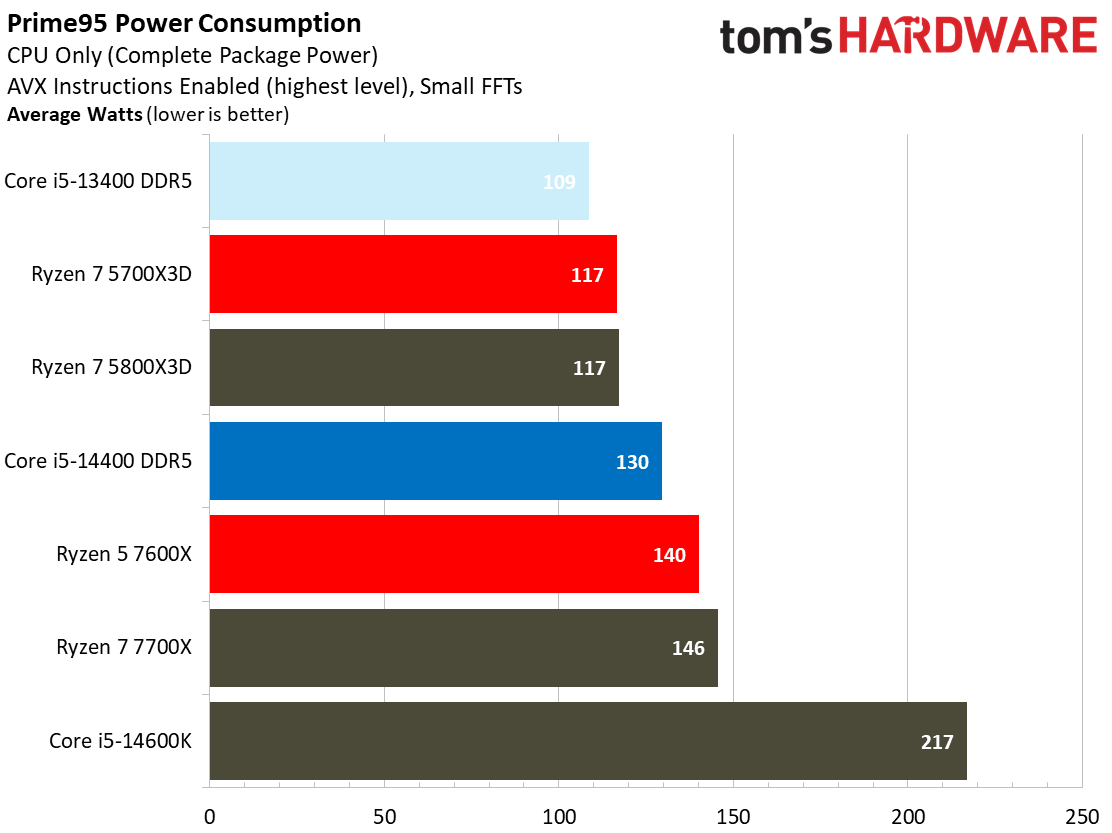
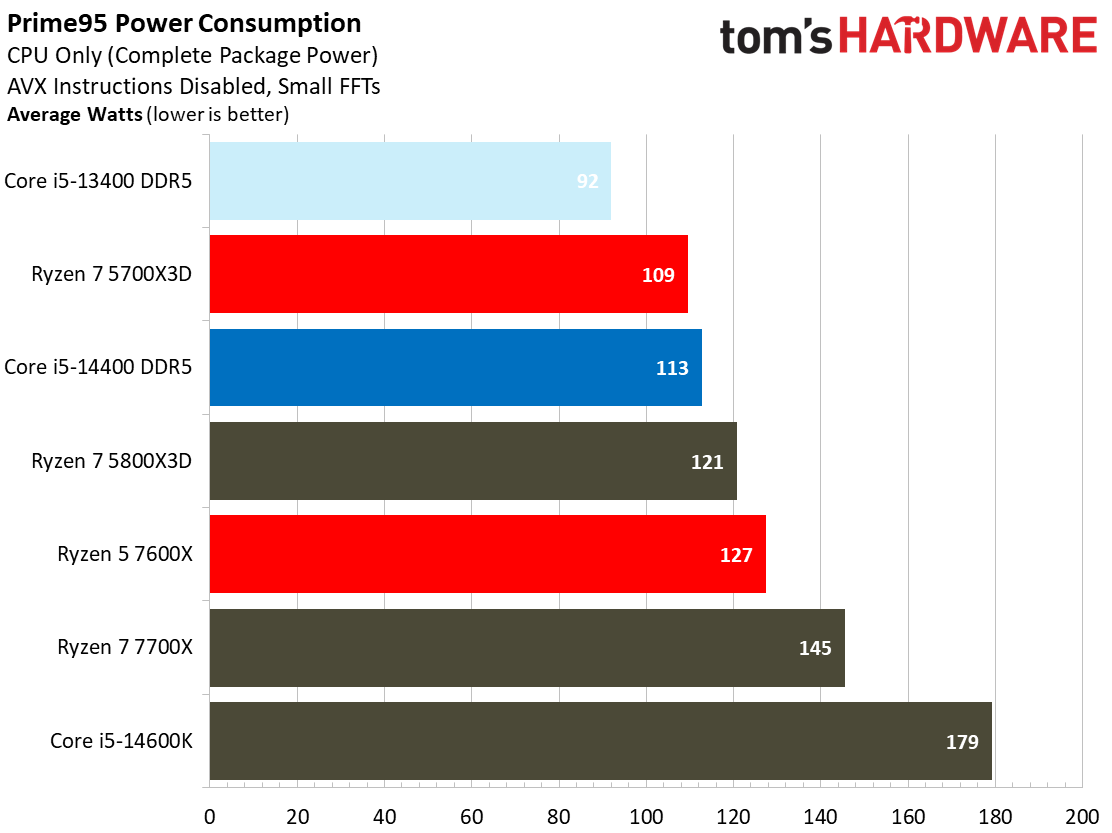
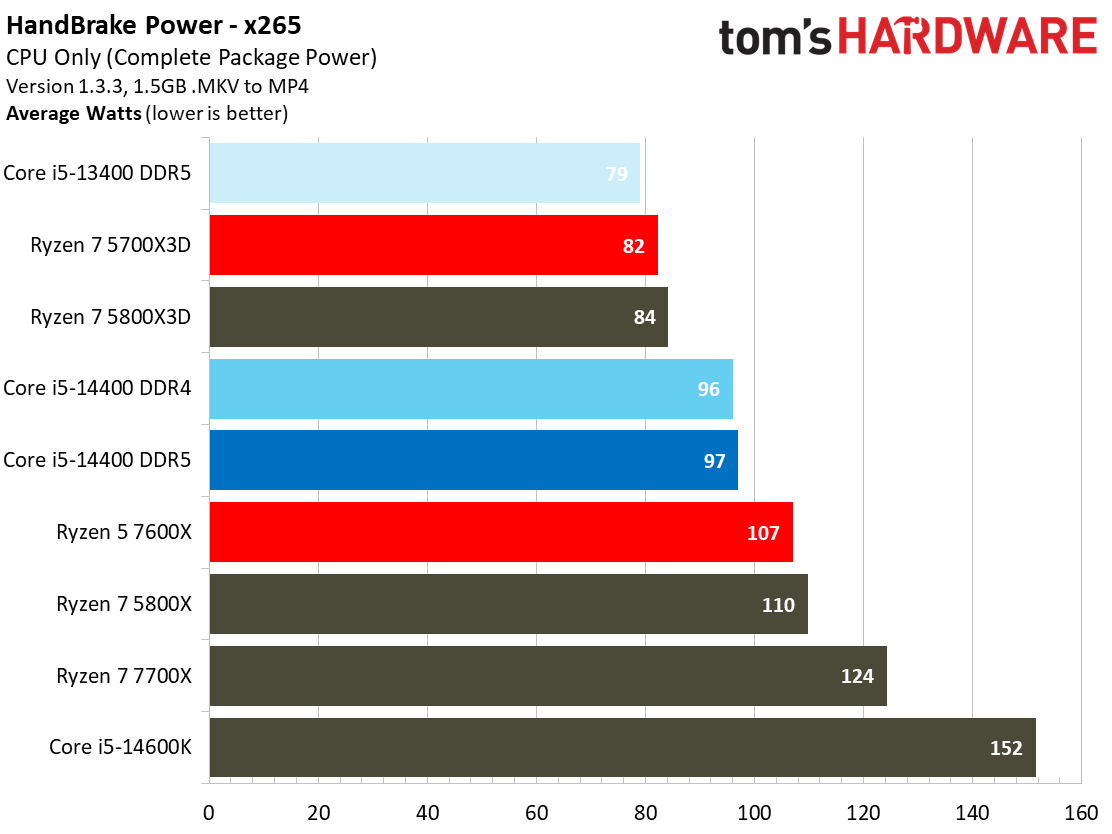
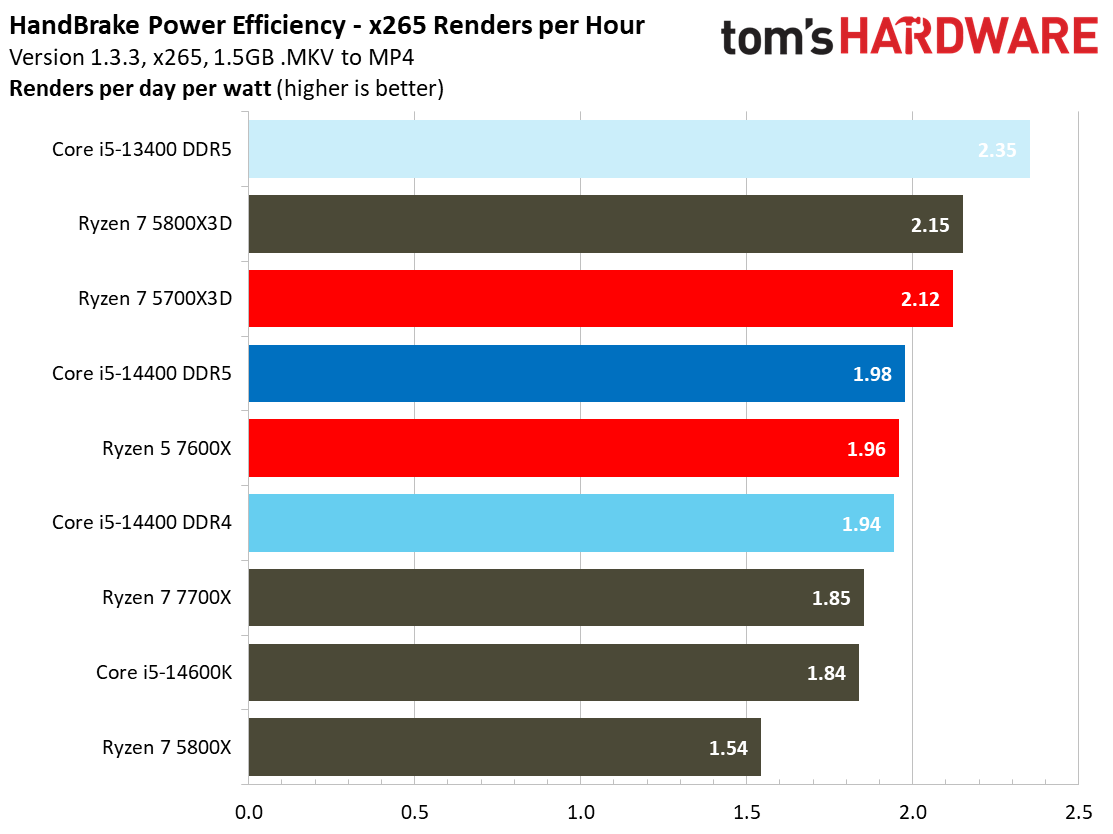

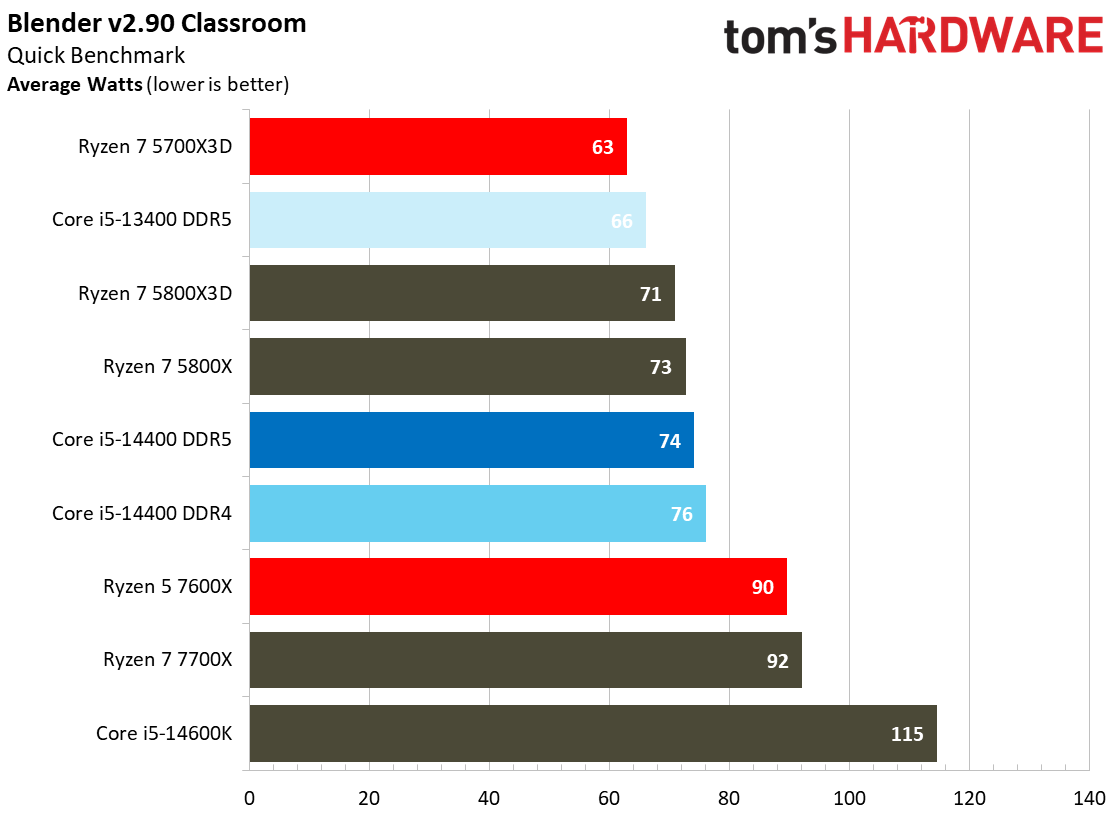
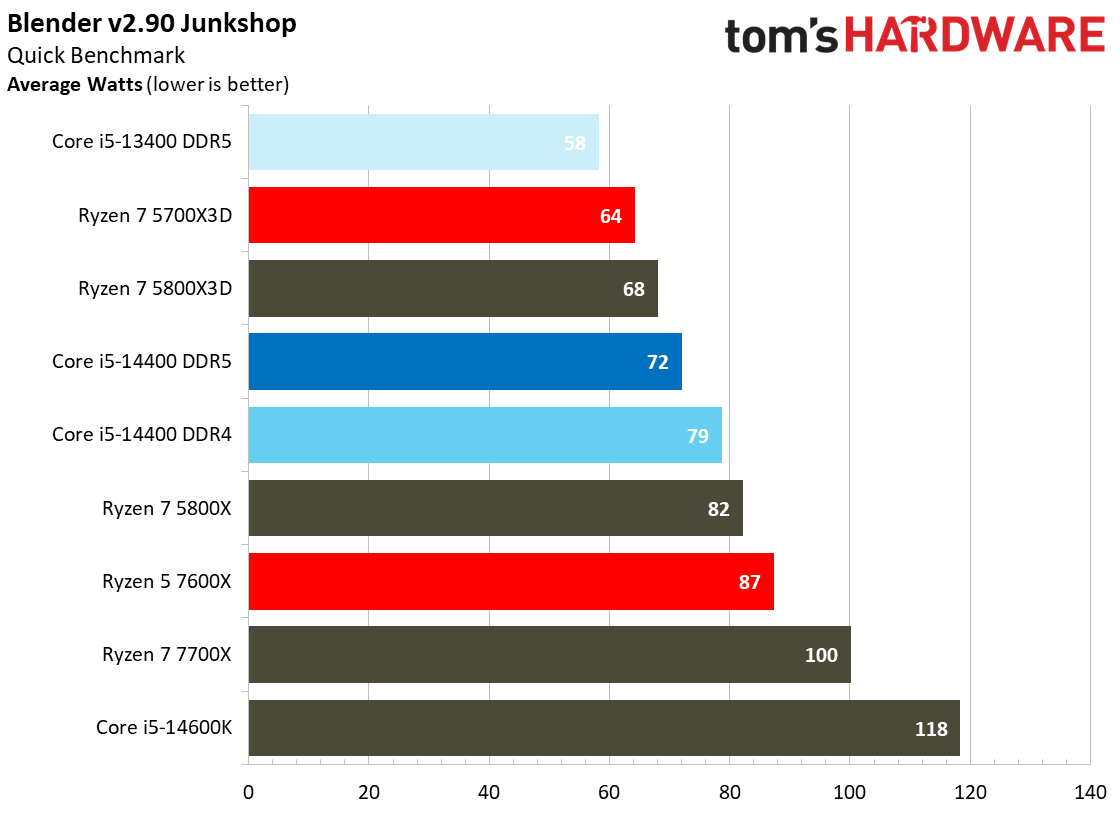
The Ryzen 5 7600X consumes ~10% more power than the Core i5-14400 in several of these workloads, but it delivers higher performance in many of them. As you can see in the HandBrake power efficiency chart, that translates to a minor difference in efficiency between the two.
The Core i5-14400 draws significantly more power than the previous-gen Core i5-13400 across the board but for limited performance gains. The Ryzen 7 5800X3D and Ryzen 7 5700X3D deliver exceptional performance efficiency despite their prior-gen Zen 3 architecture.
None of these chips suffer from significant cooling challenges — many of these models come with bundled coolers, and we've found slight performance deltas compared to using beefier coolers. As always, we recommend stepping up to at least a ~$25 tower air cooler to ensure full performance in heavy extended workloads.

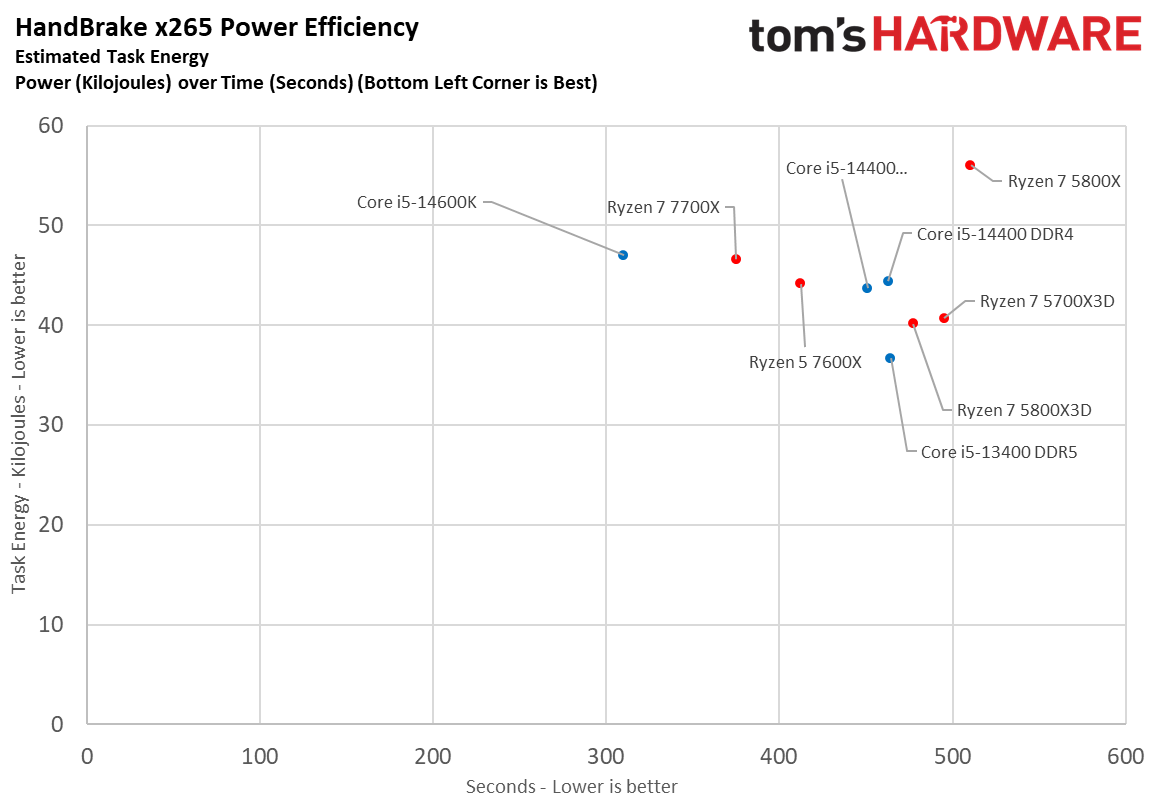
The final image takes a slightly different look at power consumption by calculating the cumulative energy required to execute an x264 and x265 HandBrake workload. We plot this 'task energy' value in Kilojoules on the left side of the chart.
These workloads consist of a fixed amount of work, so we can plot the task energy against the time required to finish the job (bottom axis), thus generating a really useful power chart. Faster compute times and lower task energy requirements are ideal. That means processors that fall the closest to the bottom left corner of the chart are the best.
The takeaway is clear — Intel's slight increases in the Core i5-14400's frequency have come at a disproportionate cost of higher power, thus yielding significantly higher power consumption for a slim increase in performance. That results in a step backward on the power efficiency front.
Intel Core i5-14400 Overclocking, and Test Setup
Intel doesn't allow overclocking of the CPU cores for the Core i5-14400. Still, as usual, we followed our policy of allowing the motherboard to exceed Intel's recommended power limits as long as the chip remains within warrantied operating conditions. Almost all enthusiast-class motherboards have similar default settings, reflecting the out-of-the-box experience. These lifted power limits equate to more power consumption and heat, but you get faster performance in exchange.
Intel allows memory overclocking with the Core i5 models, and as denoted in the charts, we added test configurations with both DDR4 and DDR5 memory. Intel has finally unlocked the System Agent (SA) voltage for its multiplier-locked models, which could enable higher DDR4 memory frequencies in Gear 1. We experimented with higher DDR4 frequencies in Gear 1 but encountered instability issues. It's possible that further tuning could rectify the issue, but we stuck with DDR4-3600 as it represents an easily attainable memory overclock that any enthusiast could dial in with minimal effort. In contrast, we simply used XMP profiles for our DDR5 memory overclocks.
As noted in the charts, we used the DDR5-6400 EXPO profile for the overclocked Ryzen 5 7600X configuration. We also used Precision Boost Overdrive (PBO) with the 'motherboard' power presets for our overclocked Ryzen 5 7600X configuration. We then enabled a 10X scalar, a 200 MHz extra boost for the CPU, and a -20 undervolt using the Curve Optimizer for the CPU cores.
Get Tom's Hardware's best news and in-depth reviews, straight to your inbox.
The Ryzen 7 5700X3D and Ryzen 7 5800X3D don't officially support CPU core overclocking, but motherboard vendors have enabled multiple workarounds to offer additional performance boosts. These chips are thought to be more sensitive to higher thermal output, so proceed at your own risk. For the sake of science, we threw in a few tuned X3D configurations using the PBO Auto setting. We also dialed up the memory frequency for the tuned configs.
Microsoft has advised gamers to turn off several security features to boost gaming performance. For maximum performance, we disabled secure boot, virtualization support, and fTPM/PTT on all systems. The table below provides further hardware details.
| Intel Socket 1700 DDR5 (Z790) | Intel Core i5-14400, Core i5-13400, Core i5-14600K |
| Motherboard | MSI Z790 Carbon Wifi |
| RAM | G.Skill Trident Z5 RGB DDR5-6800 - Stock: DDR5-4800 (non-K) DDR5-5600 (K) |
| Intel Socket 1700 DDR4 (Z790) | Intel Core i5-14400 |
| Motherboard | MSI Tomahwak |
| RAM | 2x 8GB Trident Z Royal DDR4-3600 - Stock: DDR4-3200 | OC: DDR4-3600 |
| AMD Socket AM5 (X670E) | Ryzen 5 7600X, Ryzen 7 7700X |
| Motherboard | ASRock X670E Taichi |
| RAM | G.Skill Trident Z5 Neo DDR5-6000 - Stock: DDR5-5200 |
| AMD Socket AM4 (X570) | Ryzen 7 5800X3D, 5700X3D, 5800X |
| Motherboard | MSI MEG X570 Godlike |
| RAM | 2x 8GB Trident Z Royal DDR4-3600 - Stock: DDR4-3200 | OC/PBO: DDR4-3600 |
| All Systems | 2TB Sabrent Rocket 4 Plus, Silverstone ST1100-TI, Open Benchtable, Arctic MX-4 TIM, Windows 11 Pro |
| Gaming GPU | Asus RTX 4090 ROG Strix OC |
| Application GPU | Nvidia GeForce RTX 2080 Ti FE |
| Cooling | Corsair iCue Link H150i RGB |
| Note: | Microsoft advises gamers to disable several security features to boost gaming performance. As such, we disabled secure boot, virtualization support, and fTPM/PTT. |
Current page: Intel Core i5-14400 Power Consumption, Overclocking, Test Setup
Prev Page More of the same Next Page Intel Core i5-14400 Gaming Performance
Paul Alcorn is the Editor-in-Chief for Tom's Hardware US. He also writes news and reviews on CPUs, storage, and enterprise hardware.
-
-Fran- Snake oil? Le gasp!Reply
In any case, I have to say I'm surprised the perf/$ kind of sucks with this chip (not suck, but not beat AMD as it was the case). This was the last bastion for Intel to claim "superiority" from recent memory, so it's surprising.
Thanks for the review and great data, Paul!
Regards. -
usertests I didn't realize the 7600X was that far behind the 5000X3D CPUs.Reply
Seems the gap is wider than this review:
https://www.tomshardware.com/reviews/amd-ryzen-9-7950x-ryzen-5-7600x-cpu-review/6 -
edzieba Particular for DIY upgraders, the DDR4 aspect for Raptor Lake still likely makes it more attractive in total upgrade (CPU + mobo + RAM) perf/$. Even with DDR5 getting less expensive, it will still be more expensive than paying nothing to re-use your current DDR4 DIMMs.Reply -
TerryLaze Reply
I'm just wondering, but what exactly is surprising about a company having to sell older technology for less money, or newer for more, anyway you take it.-Fran- said:Snake oil? Le gasp!
In any case, I have to say I'm surprised the perf/$ kind of sucks with this chip (not suck, but not beat AMD as it was the case). This was the last bastion for Intel to claim "superiority" from recent memory, so it's surprising.
Thanks for the review and great data, Paul!
Regards.
The 7600x was $300 when it came out...and now AMD is forced to sell it for 70% of that because of the x3d CPUs and the newer intel CPUs, even though it is current gen. -
rluker5 The 14th series pricing is not the best compared to older named products. You can buy the same chip, but faster, unlocked and at 2/3 the price at Newegg right now: the 12600kf https://www.newegg.com/intel-core-i5-12600kf-core-i5-12th-gen/p/N82E16819118349Reply
It would probably beat the 7600x(at $210) for $155. A real world performance/price thrashing. Although you would have to buy a $20 cooler if you didn't already have one: https://www.amazon.com/Thermalright-Assassin-SE-Heatpipes-TL-C12C/dp/B09Y869Z8B/ref=sr_1_20?crid=2SX1Y3LFI5SQZ&dib=eyJ2IjoiMSJ9.oWn8-RfUPfvuDzeOWU8_36bSlzc8uRnTjORmhoO2C0vsUFZ2STUVF1WtAEnZKG4Z-zUmrifpulpSJuMlZsGSFeEKCMLhJtaGVL11yTUskSdNXF1vBh_BKnhNbXbFp3tXCfLhF5edknjQiEoY5HyH03kxieOlLxKUutlOXeloABhP1HFS0d8K3bcCwNERJBSq830llUJSSoS_NVuNQxFQtR_-9MBwMGiEx6rd9EcgLtA.GH6nMT41xmldgof1e-hTaPzaY_pNrkZhB5XDJ4IX1Mo&dib_tag=se&keywords=lga%2B1700%2Bcooler&qid=1713446673&sprefix=lga%2B1700%2Bcoo%2Caps%2C104&sr=8-20&th=1 -
Roland Of Gilead The base and boost clocks for the 14400/13400 are reversed in the first table.Reply -
strobolt I don't quite understand why the article mentions "adequate stock cooler" as a pro but then also within the article it's mentioned that "we always recommend upgrading the stock cooler". If the stock cooler is adequate then what's the reason for upgrading? I understand that some people who run very extensive multithreaded workloads and in warmer climate you might end up with excessive noise and even bottlenecking but the average gamer / productivity user in a airconditioned environment probably doesn't even notice the difference. And even in gaming when you want to run high fps, the GPU is likely going to make so much noise that the CPU cooler is not distinguishable anyway.Reply -
-Fran- Reply
Saying the i5 14400 is "new" is a big stretch given is a toss between being a re-hashed Alder or a defective Raptor.TerryLaze said:I'm just wondering, but what exactly is surprising about a company having to sell older technology for less money, or newer for more, anyway you take it.
The 7600x was $300 when it came out...and now AMD is forced to sell it for 70% of that because of the x3d CPUs and the newer intel CPUs, even though it is current gen.
As for the price: Intel decided that price point, so they have only themselves to blame. I believe Intel thinks they can get away with people not doing their research (much like AMD does as well; 5700 non-G, looking at you) only looking at the price point relative to the rest.
That's what is surprising to me: why didn't Intel read the room and chose such a price point that would make them look bad. Weird. Are they with no other options anymore?
Regards.
